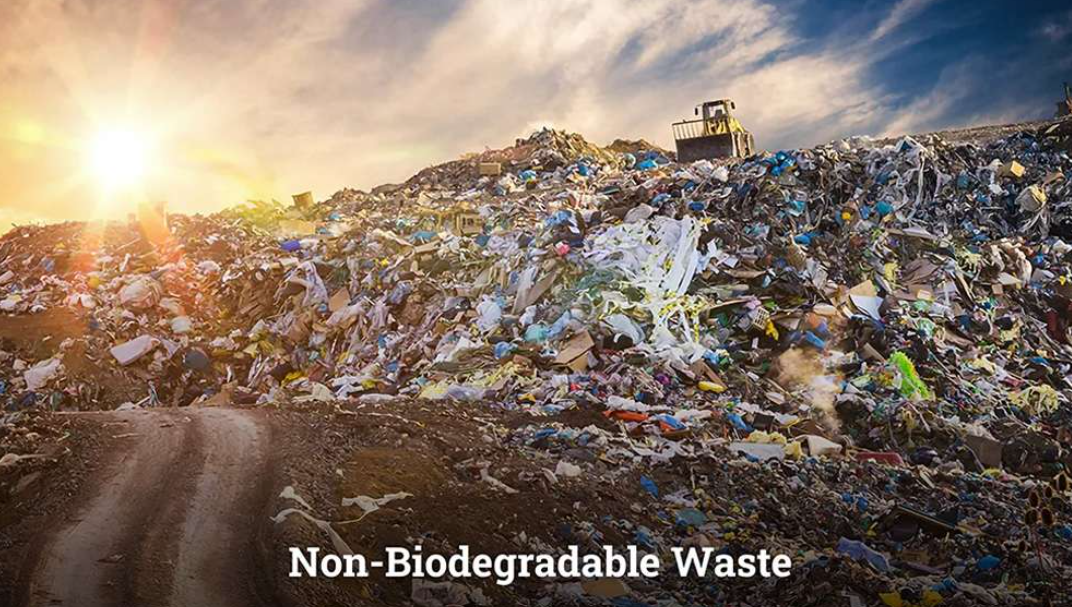In the pursuit of making India sustainable, one of the most significant environmental issues of the moment is waste management, both biodegradable and non-biodegradable. In a population of well over 1.4 billion that is said to produce approximately 62 million tonnes of municipal waste every year, the situation is direr than ever. To embark on waste management that responds to environmental and socio-economic realities in India, the foremost requirement is comprehending the essential distinction between biodegradable and non-biodegradable waste.
What is Biodegradable vs. Non-Biodegradable Waste
Biodegradable waste consists of materials that naturally break down by the action of microorganisms. Such waste materials include paper, cotton clothes, garden refuse, and leftover meals. In a typical Indian home, common biodegradable waste consists of fruit peels, leftover food, and even cow manure in the countryside—materials which can feed back onto the land as nutrients if disposed of in the right manner.
In contrast, non-biodegradable waste comprises materials that are not easily decomposable and last in the environment for centuries. These include plastics, man-made clothes, metal, e-wastes, and glass. In urban India, the fast growth of packaged consumption and digital consumption sharply augmented the amount of such non-biodegradable waste.
The Origin and Classification of Waste
From mining and agriculture to industry, construction, and homes, India produces a huge amount of waste daily. Industrial sectors contribute chemicals, plastics, and nuclear waste, while construction sites dump concrete and wood debris. Pesticides and fertilizers come from agriculture, and residential homes dispose of plastic wrappers, sanitary waste, and e-waste in alarming proportions.
Waste is also categorized as non-hazardous (such as recyclables and organic waste) or as hazardous (radioactive, e-waste, medical waste). Hazardous waste is likely to cause significant risk to health and to the ecosystem and tends to get commingled among domestic waste in Indian cities because of inadequate segregation systems.
India’s Waste Footprint and Future Projections
Globally, waste generation is expected to rise by 70% by 2050. Projects world’s waste generation increasing by 70% by 2050. In India too, the situation is desperate. As affluence and urbanization grow, inorganic waste production—particularly plastics, clothing, and metals—grows proportionately. It is estimated that countries in South Asia will experience a significant increase in the generation of waste in the years ahead, based on population growth and shifting patterns of consumption.
Another inescapable problem is that of food wastage. As an agrarian economy, India also records high post-harvest losses. Fruit and veg waste of 40% is caused by insufficient cold chains and lack of storage, whereas meat and dairy waste is caused by supply chain inefficiency and excess in cities.
The Plastic Predicament
The most pervasive non-biodegradable item is plastics, which are a recurring challenge. Approximately 3.5 million tonnes of plastic waste is produced by India every year. It chokes drains, contaminates rivers such as the Ganges, and causes marine litter in coastal areas. Over time, plastics break down into microplastics and nanoplastics, entering the food chain and causing irreparable ecological and health damage.
These nanoplastics are increasingly being detected in aquatic life and even in bottled water we drink. These particles are associated with severe health problems in animals, ranging from organ injury to disruption of reproductive systems. In humans, the effects of their long-term exposure are still in the course of study, yet preliminary results are alarming.
Bioaerosols, Heavy Metals, and Health Hazards
Even the biodegradable waste, when improperly managed, emits harmful bioaerosols—small particles in the air that harbor fungi, bacteria, and poisons. Indian workers in poorly ventilated composting facilities are frequently exposed to these bioaerosols and develop respiratory diseases and other health complications. Simultaneously, non-biodegradable trash such as batteries, electronic devices, and chemical containers discharge heavy metal ions in the ground and groundwater, especially in unregulated landfills.
A nationwide study indicates that Indian compost quality frequently surpasses the regulated levels of heavy metals through improper separation. Such contaminated compost, when applied in agriculture, transfers harmful chemicals to crops, soils, and eventually, to the diets of humans.
A Circular Solution: India’s Homegrown Innovation
Although the challenge is formidable, India is also becoming a hotbed of sustainable solutions. Case in point is Hyderabad-based social enterprise Banyan Nation, a front runner in circular plastic economy. Banyan Nation employs state-of-the-art data intelligence and cleaning technology to reclaim and recycle post-consumer plastic waste. Its superior quality recycled plastic, which is utilized by leading FMCG companies in India, is evidence of how innovation can convert waste to wealth.
Such models also need to be replicated in large numbers, merging grassroots initiatives and digital means. Local governments need to incentivize waste pickers, ensure support for cleaning material recovery facilities, and establish public-private partnerships to spur recycling infrastructure.
Managing Biodegradable Waste the Right Way
In rural India, composting has always been a lifestyle. Cow dung, waste from the kitchen, and dry leaves are composted and applied as manure. Now, urban India needs to replicate this on a large scale using modern composting bins, community compost parks, and anaerobic digestion systems.
Anaerobic digestion, in fact, is also gaining popularity in Indian cities. It decomposes organic materials in the absence of oxygen to yield biogas and nutrient-dense slurry. Biogas may be utilized for domestic cooking or electricity generation, while the slurry may be used as organic manure.
Some of the leading companies, provide customizable bio-septic tanks that digest human waste in addition to producing usable byproducts in the form of recycled water for gardening as well as biogas. These decentralized systems are perfect for environment-friendly Indian homes, hostels, and institutions.
Reducing Non-Biodegradable Waste: India’s Call to Action
Handling non-biodegradable waste in India demands a multi-pronged approach:
Reduce: Opt for minimal packaging, cloth bags, and steel containers. Avoid disposable cutlery and single-use plastics.
- Reuse: Glass bottles, old containers, and clothes can be reused creatively.
- Recycle: Participate in local recycling programs, and support brands using recycled content like Banyan Nation.
- Segregate: Ensure proper segregation at source into biodegradable and non-biodegradable bins.
Already, cities such as Indore and Mysuru are experiencing the benefits of strict waste segregation, citizen participation, and decentralized composting. These models show that a zero-waste future for Indian cities is a viable possibility.
A Shared Responsibility
Sustainable waste management isn’t just about policies and technology. It’s about collective behavioural change. Indian citizens, industries, and governments must come together to transform our relationship with waste.
Education campaigns, school curriculums, and social movements all need to support the environmental ramifications of improper disposal. From RWA-organized composting campaigns in Delhi to startups producing biodegradable festival materials in Tamil Nadu, the movement has already begun.
Endnote
India is also poised at a crossroads in environmental terms. Unless we meet it with demand for solutions through awareness, accountability, and perhaps a spattering of innovative attitude, the mountain of biodegradable and non-biodegradable waste will keep growing. From rural compost pits to high-tech recycling by firms like Banyan Nation, the solutions are already at our doorstep.
By embracing segregation, promoting local recycling economies, and converting organic waste to renewable energy, India can be the world leader in sustainable waste management. A greener, cleaner Bharat is not a dream—it is a responsibility we need to fulfil.

